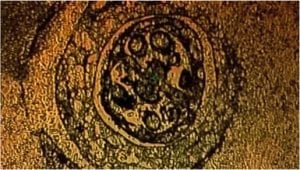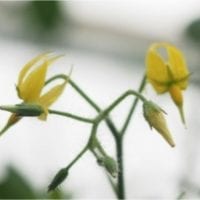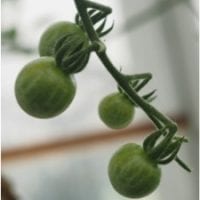News
From Flower to Fruit: Study Reveals Details of Tomato Formation
Many favorite fall harvest foods, like pumpkins and squash, once started out as the ovary of a flower, and a new study by researchers at Boyce Thompson Institute reveals just how complicated that transformation process can be.
Using advanced laser dissection and sequencing techniques, scientists have tracked which genes turn on and off in each tissue as wild tomato flowers transform into tomatoes. The study was part of an NSF Plant Genome Research project with BTI researcher Carmen Catalá and co-investigator Esther van der Knaap of Ohio State University, to elucidate the molecular networks that control fruit tissue formation, and appears in the journal Plant Physiology.
Though commonly considered a vegetable, tomatoes are the model organism for studying how a fertilized flower turns into a fruit. Previous studies have yielded information about which genes become active as fruit develops, but many of these experiments used the entire fruit, or relied on rough, manual dissection to show changes occurring in different tissues. These approaches can only offer an approximate estimate of which genes function in the tissues during fruiting.
In the current study, Catalá and former BTI postdoctoral scientists Richard Pattison and Fabiana Csukasi, used a technique called laser capture microdissection, which allows them to remove specific parts of the fruit with great accuracy. They used a wild tomato variety that is closely related to the domesticated tomato, called the currant tomato and compared gene activity in the placenta (the squishy parts around the seeds), septum (the structures that separate the clumps of seeds), pericarp (the fleshy walls of the tomato), the ovules (the part that becomes the seed), and different components that make up the seed itself. They looked at gene expression from these parts just after fertilization and four days later, as the fruit forms.
To isolate the different parts through laser capture microdissection, the researchers cut thin slices of the fruit, preserved them and then examined them under a microscope. Using an attached computer screen and mouse, they outlined where to shoot the laser.
“You can delimit the areas that you are interested in and target them to be excised from the slide and literally catapulted into a small microfuge tube; and there you have collected the cells of interest,” said Catalá. Afterwards, they can reexamine the slide to ensure that they cut out the correct part in its entirety. Catalá warns that there is some initial optimization required to ensure that they don’t fry their tomato tissues in the process.
Once the fruit are dissected by the laser, they extract the messenger RNA (mRNA) from the tissues and sequence it. By identifying and quantifying the mRNA molecules, scientists can figure out which genes are active or inactive at different points during fruit development. They used a technique called RNA-seq, which sequences and then counts the number of copies of each mRNA.
“We can gather much more information by being able to look at tissues individually and not as a whole,” said Catalá. “With laser microdissection coupled to RNA-seq, we can get both better resolution and more sensitivity, so we can basically monitor all the genes that are there.”

A slice of the ovary of a currant tomato flower, as seen on the laser capture microdissection display. The placenta in the center is surrounded by ovules.
Not surprisingly, the tracking of about 35,000 genes generates a mountain of data. BTI Associate Professor and U.S. Department of Agriculture-Agricultural Research Service researcher Zhangjun Fei and postdoctoral scientist Yi Zheng cleaned up and processed all of the sequencing data.
By monitoring how gene expression changed in the first four days after the flower becomes pollinated, the researchers could pinpoint which genes are important at different stages of development and gather more information about known biological pathways. For example, scientists know that the plant hormone auxin plays an important role in fruit development, but now they can see exactly which tissues turn on auxin signaling genes. They can also make assumptions about which tissues developed independently, and which developed together based on whether the tissues share gene patterns, or if they have their own profiles.
One surprising result was the discovery of the existence of a previously unknown gene that codes for a protein that they named OVULE SECRETED PROTEIN, or OSP. The gene had high expression levels inside the ovule, but its role in seed and fruit development is still unknown.
“The most unexplored tissues are the seeds,” said Catalá. “Usually people that study fruit development don’t pay attention to the seeds—you just scoop everything inside out. One of the nice surprises is how much information we could gather by dissecting the seeds too.” Seeds and fruits must communicate to ensure that they are both on the same trajectory, to create a successful reproductive structure.
In future work, the researchers plan to add additional time points and even more types of tissues to their analysis. Catalá and Fei are working with Joss Rose of Cornell University and fellow BTI researchers Jim Giovannoni and Lukas Mueller to create a highly visual, clickable database where users—most likely tomato researchers—can access images and gene activity of tissues as they develop into fruit.
The video below shows the process of removing the placenta from the ovary of a currant tomato using laser capture micro dissection. The scientist outlines the placenta on the screen, using the attached computer, and then a laser catapults the tissue into a tube for use future experiments.
Subscribe to BTI's LabNotes Newsletter!
Contact:
Boyce Thompson Institute
533 Tower Rd.
Ithaca, NY 14853
607.254.1234
contact@btiscience.org
Copyright © 2023 | Boyce Thompson Institute | All rights reserved | Privacy Policy | Cookie Policy





